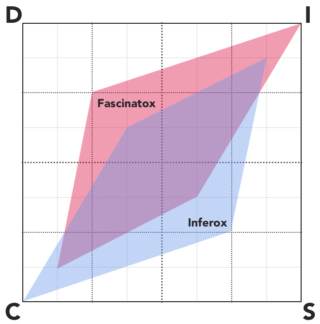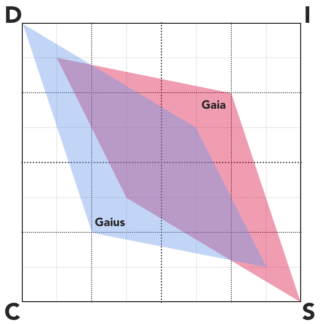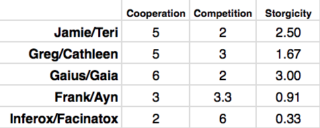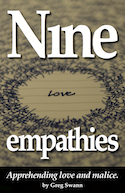
“I can’t get no… satisfaction…”
That’s the picture I made the other day of the hypothetical marriage of Inferox to Facinatox, the least Ds, most Ci couple I could imagine. If Gaius and Gaia, the counter-vailingly hypothetically perfect married couple, are most-perfectly fecund – most likely to have a lot of kids who have a lot of kids – Inferox and Facinatox are the pair least likely to breed, or even to bond in any kind of storgic relationship.
I was writing about Ayn Rand’s awful marriage, and we’ll come back to that. This is what I said about my two botched lovers: Inferox “is every way the opposite of masculine ferocity,” while Facinatox “is in every way the extreme presence of feminine ferocity.”
You can see these two as the central characters in the song “Creep.” He’s fat, slobby, schlubby, scruffy, awkward and shy – an involuntary celibate. She’s sleek and shiny in every way, repelling him like raindrops off a mirrored windshield. How could these two ever work as a couple? She’s a big star and he’s her dog-like devoted manager/driver/valet. That’s not a marriage, but it could last anyway.
I thought about them some more Sunday, in much the same way I might peer with wonder and revulsion into a skink’s lair: This is alien to me, but it’s interesting and informative, even so.
In notes on Facebook, I said:
This is Oneitis, among many other bizarre couplings.
Swap the genders either way and it’s “Fifty Shades of Control Freak.”
Uncouple it from actual coupling, or at least bonding, and you get polygamy/polygyny – along with involuntary celibacy, porn and dutch-wivery.
Divorce it from actual reality and you get a Farah Fawcett or Betty Grable poster with an entourage composed of a million drooling eunuchs.
Back to real life, I can see this as a marriage of mutual beards, or any blatantly-uncommitted marriage, gay or just twisted.
This is a “love” built on compliance and fascination – unilateral both ways, with as little reciprocity as possible in either direction.
This is the “love” portrayed in all those vampire, zombie and drug/sex/attention-addiction movies.
This is the “love” of systematic, organized dating – a love built entirely on quantifiable results, not storgic love, family life or fond memories.
And here’s the really sad part: This was the “love” sought and promoted by Ayn Rand: A narcissistic celibacy of unrequited fascination, where the measure of my love is how enduringly proudly I have suffered for it.
The Big O saw love as the big O – as savage, bloody, bruising love-making – but only after a decade or so of self-imposed celibacy, sometimes abated, for the woman in the dyscouple, by adultery.
Most of what Rand wrote about love is nonsense, sentiment bingo, so I won’t pick at it. What she portrayed, repeatedly, was that marriage is a lifelong affair carried out with as close to zero contact as possible. The man, in particular, can only prove his love by year-after-year of voluntary celibacy. The woman achieves her own misery more actively, by regretting having slept with less-than-ideal men.
This dyscouple are made-for-each-other why? Because everyone else hates them. They get together when? Almost never, until the very end of the book, after which they vanish. Kids? Hah! Time alone together? Nah. Even their concussive, abrasive coupling is brief. What most makes for the very highest kind of love, for Ayn Rand, is a nearly-infinite, barely-endurable separation in space and time, punctuated at long intervals by a savage, spastic, sado-masochistic coital frenzy, after which the misery resumes. Love in the persistently-irrational world of Miss Rationality is the violently temporary attraction of what are normally mutually-repulsive magnets.
There’s more: Love is a response to values, none of which are visual – it came out later in Rand’s life – so fat is beautiful and fat and dumpy is ravishing. Adultery isn’t wrong when only the man is lawfully married. Or when you don’t love your spouse. In any case, you can tell it’s all perfectly moral because you hide it from everyone – then lie about it for decades.
When you take a good long look into Ayn Rand’s writing, you see her staring back at you, rationalizing the life choices she clearly regretted by discursive absolution, tu quoque and two-wrongs-make-a-right enacted again and again as set pieces.
What’s worst about all of this? Ayn Rand had no idea what love is.

The look of love…
I swear I could rewrite I Corinthians 13 from that image – but I can marry people now like I never could before.
Note that Gaius and Gaia are aligned along the Driven-Sociable axis, where Inferox and Facinatox align the other way, along the Cautious-Incandescent axis.
Driven and Sociable are both reciprocal social strategies: We each get what we want by helping each other get what we want – which in a marriage are typically the same things, anyway.
Cautious and Incandescent are both unilateral social strategies: I will pursue what I want even if you don’t get what you want – or even if I block your access to what you want or outright take what you have.
That sounds really ugly until you catch yourself hustling to beat a little old lady to the grocery checkout stand. First position was hers by right of first-come-first-served, but you usurped it, you knave! We are all of us each one of these things – Driven, Incandescent, Sociable and Cautious – in different measures, and everything short of actual crime is civil concourse – at least de jure – fair game.
But: D and S are inherently cooperative, where C and I are naturally competitive: You can’t hog all the limelight and share it with me, and I can’t take or even share in the blame for your graduated-sociopathy at the supermarket.
The values I pursue along the C/I axis are often solitary values, and my pursuit of them can seem to be a zero-sum game to you: I only get time to ‘follow my passion’ by sticking you with what should have been my share of the drudge-work. Don’t worry, though: By the asymmetrical math of marital grumbling, you’re always screwing me out of what I want, too.
Accordingly, pursuing values along the D/S axis tends to pull couples closer together, while one or both partners focusing on the C/I axis will tend to pull them apart.
Cooperation breeds companionability, where competition seeds conflict, and those echo outward. We most become a couple by coupling, which can’t be done apart. Still worse, marriage consists of doing stuff together, which competitors cannot do cooperatively and the solitary cannot do at all.
Good times make for good memories – which delight repeatedly, alone or shared, deliberately called to mind or blooming unbidden.
Bad times leave bad memories. You never deliberately recall them, wincing when they call themselves to your notice unbeckoned – and you never share them, except as weapons.
And therefore, more-cooperative marriages will tend to get better over time, where more-competitive marriages will get worse.

“More prostrate, Frank! You’re blocking my light.”
Again: Yikes! They are more competitive than cooperative – a completely redundant statement of the history of this benighted couple.
But look how closely Rand (Cids) maps to Inferox (Cisd) and Facinatox (Icds). They’re like the two kids she never aborted. And whatever it is any one of these three might be looking for from love, in all three cases it is the very opposite of reciprocal cooperation.
The love of friends is fungible. The love of lovers is fragile. But the love of families endures. This is storgic love, the love that weathers slights, insults, even betrayals. If a true marriage is what Gaius and Gaia have best, then marriage is a lifelong storgic commitment to mutual and reciprocal cooperation: Two bodies, one love, one ideal, one destiny.
Restated in brief: Marriage is Ds. Dysmarriage – a most unstable isotope – is Ci.
Every couple falls somewhere between these two imagined extremes, of course, but the closer your marriage comes to resemble Gaius and Gaia’s everlasting honeymoon, the more you’ll find to love in your marriage – and the less you’ll regret it, lament it, lash out at it or yearn to escape it. Verbum sapienti: Change your habits now so you won’t have to change your last name or mailing address later.
I have the seed of a math for this. What I have now is pre-alpha, a methodology deployed here with the estimates of estimates we’ve been working with, thus to illuminate the relative Storgicity of each marriage we’ve talked about:

I’m a long way from being able to diagnose and action-plan marriages, but there is a headline here for anyone with a need:
I can quantify love.
Cooperation / Competition = Storgicity. Recurring events amplify, as do their echoes in memory, so the actual felt effects of that Storgicity will scale over time: Good marriages will get better – and less fragile – while bad ones will get worse if they don’t break apart.
Meanwhile, I have by now spent way too much time thinking about Inferox and Facinatox. They have nicknames for each other, so you know. She calls him ‘Bungled.’ He calls her ‘Botched.’ They’re going out tonight, by separate cars, to a nightclub called Eschaton, where they plan to ostentatiously ignore each other for hours on end.
And if that ain’t love…















